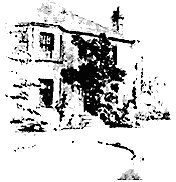Gomer House
This is part of a local history note on R D Blackmore. Start of this local history note.
 Gomer House, Teddington (1898). Sketch
Gomer House, Teddington (1898). Sketch
The land selected was a 16 acre plot at Teddington which Blackmore had seen and admired for some time. Here he built his new house, completed in 1860, in which he lived for the rest of his life. He called it “Gomer House” after one of his favourite dogs, a Gordon Spaniel. In the extensive grounds he created an 11 acre market garden specialising in the cultivation of fruit. The grounds were surrounded by high walls which served to keep out thieves and to aid the ripening of tender fruit. His knowledge of horticulture was extensive, but because he lacked the necessary business sense, the garden was not a very profitable enterprise.
At the time Blackmore came to Teddington, the railway had not yet disturbed its quiet rural atmosphere. Before long, however, plans were in hand for the purchase of land and the construction of lines. In 1868, Blackmore won a fight against the claims made on his property by the London and South West Railway Company, but he was unable to prevent the building of the railway station almost directly opposite his house.
Blackmore’s best known and most successful novel, Lorna Doone (1869), established him in the front rank of British novelists of that time. With it, he pioneered a new romantic movement in English fiction. The novel’s overwhelming success with the public was achieved when it appeared in a popular one volume edition as distinct from the three volume form in which it was originally published.
Some local residents in Teddington apparently regarded Blackmore as somewhat unsociable, if not misanthropic. Charles Deayton, a Teddington merchant, is recorded as stating to a visitor:
"He is not a social man, and seems wedded to his garden in summer and his book writing in winter. That is all I know about him; except that he keeps the most vicious dogs to protect his fruit, and I would advise you to avoid the risk [of visiting him]."
This statement gives a rather distorted picture of Blackmore’s character. Although Blackmore was a man of a retiring disposition, preoccupied with the demands of writing and fruit growing, he did, in fact, have a number of very intimate friends whom he met regularly. His works had a wide following in the United States and during his life he formed many friendships with Americans.
His wife’s health began to deteriorate and became critical by the beginning of January 1888 and she died at the end of that month. The funeral was held on 3rd February 1888 in Teddington Parish Church and she was buried in Teddington cemetery. After her death, Blackmore was looked after by her nieces, Eva and Adalgisa Pinto-Leite. Blackmore died at Teddington on 20th January 1900 after a long and painful illness and was buried next to his wife.
The two nieces continued to live in Gomer House; Eva died in 1911 and was also buried in the Blackmore grave. Then in October 1938 there was an auction of all its contents, which included Blackmore’s own library containing first editions of his works. The house itself was later demolished and Doone Close, Blackmore’s Grove and Gomer Gardens were built, reminding us of the novelist’s associations with Teddington. The end of Doone Close marks the approximate site of Gomer House. Blackmore’s market garden covered the area between the present Station Road and Field Lane.
Some of Blackmore's published work
- 1854 - Poems by Melanter
- 1854 - Epullia - a collection of poems.
- 1855 - The Bugle of the Black Sea - a patriotic poem inspired by the Crimean War.
- 1862 - The Farm and Fruit of Old - a translation of the first and second Georgics of Virgil.
- 1864 - Clara Vaughan - his first novel, published anonymously.
- 1866 - Cradock Newell - described by the author as a tale of the New Forest.
- 1869 - Lorna Doone - a romance of Exmoor.
- 1872 - The Maid of Sker
- 1875 - Alice Lorraine
- 1882 - Christowell
- 1884 - Tommy Upmore
- 1889 - Kit and Kitty - a novel in which Blackmore utilised his wide knowledge of horticulture.
Up to: Richard Doddridge Blackmore
Updated: 08 July 2016
 Stay up to date! Make sure you subscribe to our email updates.
Stay up to date! Make sure you subscribe to our email updates.
